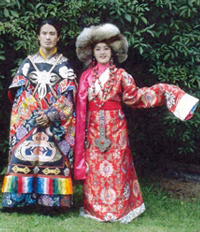
Tibetan dance developed in a remote mountainous region, which simultaneously captured and preserved the art form, while cutting it off from outside influences. The Tibetan folk opera, known as Ache lhamo (which literally means "sister goddess" or "celestial sister"), is a combination of dances, chants and songs. The repertoire is drawn from Buddhist stories and Tibetan history. The masked dances depict the hunter and his costumes. Tibetan opera has a narrator who tells the main story, while arias are sung by the various characters to communicate with each other. Dance, song, narration and aria are the main components of the performance. The theme of the stories center on Buddhism and kindness. In old Tibet, one story could be performed for a week. There are eight major stories that have been performed by different Tibetan opera groups in the past. Sometimes identified by shamanistic influences, Tibetan dance invokes and reflects the natural and spiritual worlds.




